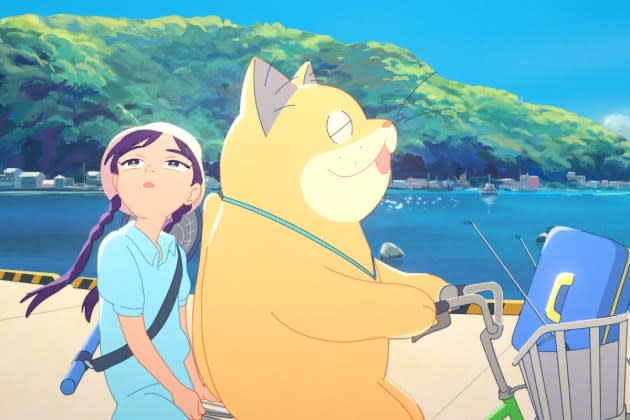‘Ghost Cat Anzu’ Review: Made With Rotoscope Techniques, Unusual Anime Plays Like a Sardonic Relative to ‘Spirited Away’

Form and content align in the uniquely conceived and delightfully offbeat supernatural adventure “Ghost Cat Anzu.” For a movie about a reality where mortals and otherworldly spirits coexist on the same plane, the filmmakers decided to compound the flesh-and-bone realism of live action cinema and animation’s fantastical qualities. While the plot takes some jarring turns, its impish tone stays consistent throughout, making for a wildly enjoyable (if a bit perplexing) Japanese animated effort on its own wavelength.
Shot first with actors whose voices were also captured on location, this adaptation of Takashi Imashiro’s mid-2000s manga of the same name (written by screenwriter Shinji Imaoka) necessitated two directors. Nobuhiro Yamashita was in charge of staging the interactions between the cast to capture their subtle expressions. Then that footage served as the basis for the rotoscoped animation directed by Yôko Kuno with artists drawing over each frame to transform the images filmed into lively animation with striking painterly backgrounds — which are said to be inspired by neo-impressionist works and deliver on thar promise. The combination results in noticeably fluid movement and greater facial expressiveness in characters with a more cartoony or graphic aesthetic than most anime.
More from Variety
Running from loan sharks, widower Tetsuya (Munetaka Aoki) returns to his rural hometown of Ikeru, to ask his father for money after 20 years away. The elderly man, who runs a Buddhist temple, refuses. Tetsuya leaves his 11-year-old daughter Karin (Noa Gotô) behind, promising to return for her by the anniversary of her mother’s death. She will soon come into contact with Anzu (Mirai Moriyama), a 37-year-old, giant, anthropomorphic cat who looks somewhere between a sports team mascot, the popular Japanese cartoon character Doraemon and Mei’s red panda form in Pixar’s “Turning Red.”
From the moment Anzu casually pulls up to the temple riding his motorcycle to no one’s shock, it’s clear that spirits like him live, and work, alongside humans here. Later, a handful of other divine entities — including a giant frog, a tanuki (remember Studio Ghibli’s “Pom Poko”?) and a humanoid mushroom — will come along to help the stubborn Karin.
Anzu’s infectious laughter, reflected not only in Moriyama’s voice performance but in the way his facial features resemble those of a classic comic strip, synthesizes the playfulness of the character. As explained early on, Anzu started out as an average feline, but as the decades went on, he didn’t die, instead gaining human traits until he effectively replaced the absent Tetsuya. There’s a curious stylistic distinction in the character design between the Ikeru locals — such as the boys who become Karin’s fast friends — whose faces feature dots for eyes and minimal detail, and outsiders like Karin, whose more intricate pupils and overall look more closely resemble Japanese animation viewers might be familiar with.
For the first half of the tale, Karin and Anzu, who is also a chiropractor and enjoys gambling, work odd jobs together and hang out with the other sprites. These vignettes of time spent living in close proximity to nature fade to the back burner when Tetsuya fails to return, prompting Anzu and Karin to leave the countryside for Tokyo. In the big city, and with the help of the God of Poverty, the pair travels to the depths of hell to bring Karin’s mother back. The underworld here calls to mind the bathhouse in “Spirited Away,” which is likely due to a shared spiritual tradition in Japan rather than being a direct homage.
But even if there are visual touchstones that somewhat mimic elements of Miyazaki’s masterpiece, the sardonic nature of “Ghost Cat Anzu” ensures we don’t compare them. The jump from quotidian mischief to a full-blown battle with a legion of demons feels slightly disorienting, despite the fact that the narrative establishes the existence of creatures beyond human comprehension from the onset. Still, the characters have such acidly whimsical personalities that it’s not hard to follow them even on the most outrageously puzzling of missions. While Karin’s determination to spend more time with her mother in the absence of a reliable father does enrich the film emotionally, one complaint is that the mechanics of how hell or the afterlife in general operate are never expanded on.
Imaoka’s writing and Gotô’s acting render Karin a complicated young person grappling with feelings of abandonment. The animated comedy believably portrays children not as unimpeachably innocent, but capable of cruelty and anger — a quality this movie shares with some of the best productions, animated or otherwise, aimed at young audiences. That said, the creators don’t refrain from giving in to the juvenile humor of a loud flatulence, finding space for a multitude of emotions within one unassumingly magical story. Though perhaps not transcendental, “Ghost Cat Anzu” charms all the same.
Best of Variety
Sign up for Variety’s Newsletter. For the latest news, follow us on Facebook, Twitter, and Instagram.

 Yahoo News
Yahoo News 